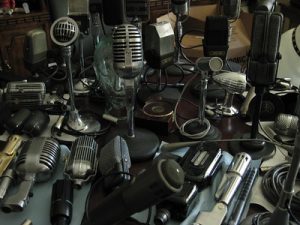 The call from the client was “Can we borrow your camera? We’ve only got one, and we need two for the next test”. We agreed a modest fee and the deal was done. Or was it?
The call from the client was “Can we borrow your camera? We’ve only got one, and we need two for the next test”. We agreed a modest fee and the deal was done. Or was it?
Close questioning revealed that they were planning ‘Wizard of Oz’ testing on a voice application. The participant would be in room A, with a scenario and the option of filling in a paper form or going direct to telephoning the answers. An evaluator would be in room B, with the script for the eventual voice response system. The observers would be in room C, and wanted to view the participant and hear both sides of the telephone conversation.
OK, so we can have two televisions in room C. By running a cable, or using a video sender (mine’s a cheap-and-cheerful Thomson VS530CU) the observers can see what is going on in rooms A and B. But hang on, that means they’ll have two separate recordings from the two cameras so how are they going to co-ordinate them when they’re viewing the tapes later?
Hmm. My first thought was ‘video mixer’, but the video mixer takes a picture from the second camera and mixes it with the picture from the first camera. The evaluator confirmed that she only wanted the sound from room B, not the picture.
Second thought: there must be an audio mixer that works like a video mixer, but for sound. OK, ten minutes on Google and a few quid and I’m done.
But no, my searching finds plenty of software for mixing sound on the computer – no dinky little box that will do the job without a computer. Looks like a trip to Tottenham Court Road is going to be needed.
problem solved?
As I’m packing up to go, a thought struck me. Surely this is what stereo was made for? Instead of plugging a single, stereo microphone into the camera, why not pick up the left channel from the participant and the right channel from the evaluator? I find the two mono microphones, a cable that converts two phono connectors to a stereo mini-jack, and a selection of extension cables. Off they go to the client. Wish I could be there to put it all together but it seems easy enough so I’ll wait for the phone call that confirms it.
You’ve guessed: it didn’t work. Panic phone call to the sound engineer who helps me out on these things. It seems that the stereo microphone I have been using has its own internal power source, whereas the mono mics need to pick up power from whatever they are plugged into. The video camera mic input doesn’t give a power output.
So now I need two powered mics. I have a one, and the client has an identical one – both stereo. Each outputs a left channel and a right channel. We’ll put the left channel from one mic into the left channel of my two-phono-to-stereo-mini-jack adaptor, and the right channel from the other mic into the right channel of said adaptor. All we need is two adaptors that go from stereo-mini-jack to two phono, and I’ve got one of them. Off to Tottenham Court Road. While I’m there, find out that I can get an audio mixer suitable for a DJ – lots of outputs, only one mic input, so that’s no good. Or I can get an audio mixer suitable for a musician: zillions of inputs, much too complicated for what I need. Instead, I hand over £4.99 for the missing adaptor, zoom back to the client’s office, plug the microphone for the evaluator into a long extension cable that I happened to have already, and it’s working.
Apart from the buzz. But the buzz seems to go away if we check that everything is plugged in really, really tightly. We pack up and arrange to meet at the hotel where the client is testing.
A couple of days later… it’s the morning of testing. It’s working – or is it? The buzz has returned. Fortunately one of the observers has an idea: maybe the ‘spare’, dangling phono plugs from the unwanted channels are causing the problem. When we ground them by touching the point of each spare plug to the metal sleeve of one of the plugs in use, the buzz diminishes or even disappears. Liberal use of masking tape to hold them in place and the client’s testing can go forward.
So that was easy, wasn’t it?
Anyone with a sensible solution to this problem: please email caroline.jarrett@effortmark.co.uk
P.S. The voice application tested pretty well.
This article first appeared in Caroline’s Corner, in the 23 January edition of Usability News.
Featured image: Microphones by Roadside Guitars, creative commons licence
